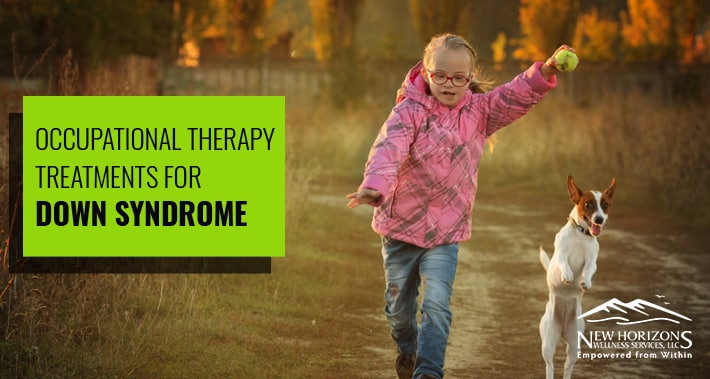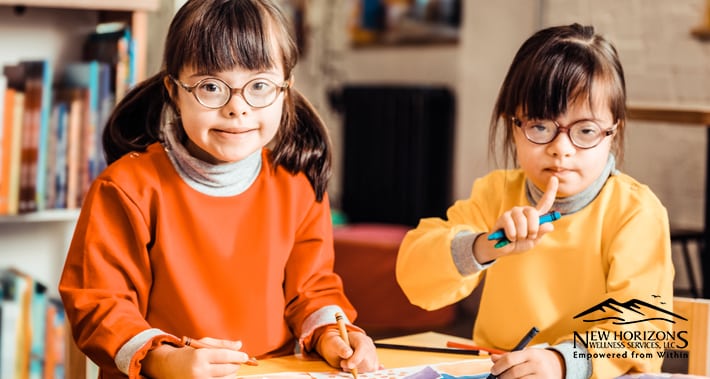
If you’re caring for a child with Down syndrome, you might be concerned about your child’s development.
It’s common for children with Down syndrome to struggle to pay attention or to move their body the way they need to.
It can be tough to manage these challenges, but occupational therapy for children with disabilities can help you build key movement skills with your child.
Down syndrome is the most common genetic disorder in the United States, but both children and adults across the country have learned to live full and satisfying lives with it.
Keep reading to find out more about Down syndrome, its causes, and what you can do to promote your child’s movement and motor skills if they have Down syndrome.
What Is Down Syndrome?
Your genetic material is stored in the nucleus of your cells.
It’s where you get any traits you inherit from your parents – the color of your hair and eyes, whether or not you can roll your tongue, and whether or not you have dimples are some examples of inherited traits.
Typically, each cell has 23 pairs of chromosomes, half of which come from each of your biological parents.
If you have a child with Down syndrome, they have either a partial or a full extra copy of chromosome 21.
This additional genetic material can alter the course of development, and create the characteristics associated with Down syndrome.
Down syndrome is a condition that will affect your child into adulthood.
With support and intervention, however, people with Down syndrome can live full and happy lives.
Down syndrome can affect your child’s motor skills, which are necessary for activities like eating, dressing, and playing.
Are There Different Types Of Down Syndrome?
There are three types of Down syndrome: trisomy 21, translocation, and mosaicism.
Trisomy 21 is the most common kind of Down syndrome and it occurs when there is another copy of chromosome 21 in every cell.
Translocation is a form of Down syndrome where a child has the typical number of 46 chromosomes, but with an extra piece of chromosome 21 attached.
Translocation doesn’t include people with the full chromosome 21.
Mosaicism is a type of Down syndrome where some cells of the body have an extra chromosome.
Mosaicism tends to lead to fewer symptoms than other types of Down syndrome.
Characteristics Of Down Syndrome
Down syndrome can present itself in developmental, physical, and medical characteristics, which can vary greatly across individuals.
Some children may also show impulsive behavior as a result of Down syndrome, and it might take them longer to learn new concepts compared to other children the same age who don’t have Down syndrome.
Physical characteristics of Down syndrome are most prominent in the head, face, and neck.
Children with Down syndrome often have shorter necks, flat facial features, and smaller heads and ears.
They might also have a tongue that tends to stick out of their mouth and eyes that slant upward.
People with Down syndrome might also have atypically shaped ears and poor muscle tone.
An infant with Down syndrome can be average sized at birth but will develop more slowly than a child without the condition.
Other health conditions may occur more frequently with children who have Down syndrome.
These may include heart defects, leukemia, late tooth growth, and hip dislocation.
Children with Down syndrome may have a weaker immune system which makes them more prone to respiratory infections, urinary tract infections, and skin infections.
They may often experience sensory overload, in particular becoming overwhelmed by unexpectedly loud sounds, but may also enjoy listening to loud music.
In addition, hearing loss is a common symptom of Down syndrome.
Just like all other people, individuals with Down syndrome may have sensory processing disorder.
If that’s the case, occupational therapy intervention sometimes includes treatments for sensory processing disorder.
Children with Down syndrome often have issues with speech and communication as well, so they can often benefit from pediatric speech therapy treatments alongside occupational therapy.
Those with Down syndrome sometimes have delayed social communication skills
Just like all children who struggle with social skills, they can benefit from support to gain these skills.
It’s important to note, however, that every person with Down syndrome is unique, and these characteristics may occur at different levels, or not at all.
Causes Of Down Syndrome
Most people have 23 pairs of chromosomes, which make up a total of 46.
You receive one set of 23 from each parent, creating the pairs.
Down syndrome is caused when one of the pairs of chromosomes doesn’t separate properly and it results in a child having an extra or partial copy of chromosome 21.
This extra chromosome causes the brain and physical features to develop differently.
But why does this chromosomal abnormality happen?

How Can Occupational Therapy Help Children With Down Syndrome?
Occupational therapists work with children who have Down syndrome and their families to help them reach their potential as they grow.
An occupational therapist can help parents and caregivers learn how to support a child with Down syndrome at each stage of development.
The sooner you begin working with an occupational therapist, the better your child’s outcomes are likely to be.
Babies and young children with Down syndrome can benefit from occupational therapy by working with an occupational therapist to strengthen the muscles in their cheeks, tongue, and lips, which helps during feeding.
The occupational therapist can also teach self feeding skills and determine if adaptive equipment will help to increase independence.
During early childhood, occupational therapy can help children with Down syndrome focus on motor skills for independence, improving low muscle tone, core stability and loose ligaments at the joints.
An occupational therapist can help a child to learn how to do self care skills such as getting dressed, brushing teeth, taking themselves to the bathroom or following a bedtime routine.
School-aged children with Down syndrome can work with an occupational therapist to master self-care skills like zipping a jacket, helping with chores at home and keeping track of supplies in a school backpack.
Fine and gross motor skills like cutting with scissors and writing and playing on the playground are addressed to help the child to be successful in the classroom.
Occupational therapists can even work with your child’s school to make their classroom spaces more accommodating and appropriate to your child’s abilities and can work on communication skills through printing, building handwriting skills, and keyboarding.
Book Your Appointment With New Horizons Wellness Services Today
If you want to learn more about how you can help your child with Down syndrome achieve their fullest potential with occupational therapy, get in touch with us now.
Our qualified occupational therapists have extensive experience working with children with Down syndrome and can use their training to support your child.
During your first appointment, you’ll meet with your occupational therapist, who will be carefully selected for you based on the needs of you and your child.
Your occupational therapist will ask questions to learn more about the challenges your child is facing and come up with solutions to meet your child’s goals.
They will also work with you on a treatment plan that includes activities you can do with your child at home, in addition to regular sessions at the clinic.
To start your child’s journey to greater independence, book an appointment with us today.
Yours in Health,
New Horizons Wellness Services13333 SW 68th Pkwy,
Tigard, OR 97223
- https://g.page/newhws
New Horizons Wellness Services provides a true multidisciplinary approach to mental & physical health treatments for children, adults and families.
